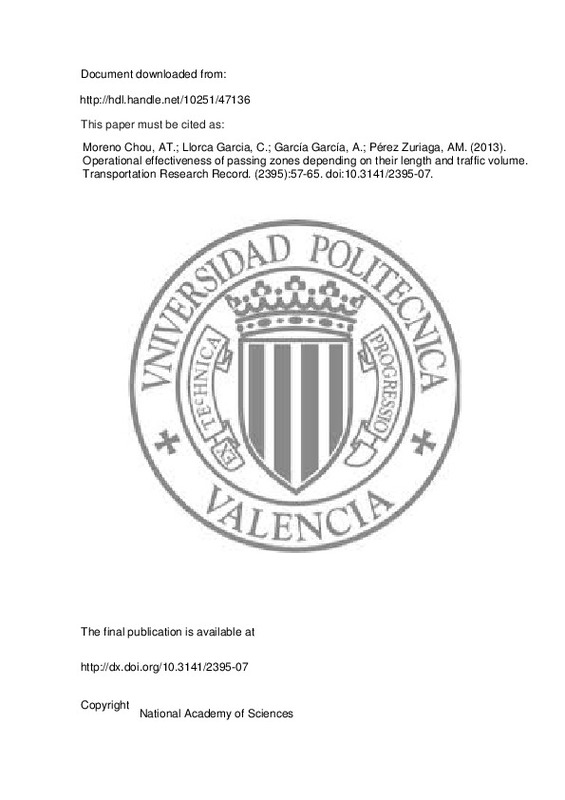JavaScript is disabled for your browser. Some features of this site may not work without it.
Buscar en RiuNet
Listar
Mi cuenta
Estadísticas
Ayuda RiuNet
Admin. UPV
Operational effectiveness of passing zones depending on their length and traffic volume
Mostrar el registro sencillo del ítem
Ficheros en el ítem
| dc.contributor.author | Moreno Chou, Ana Tsui
|
es_ES |
| dc.contributor.author | Llorca García, Carlos
|
es_ES |
| dc.contributor.author | García García, Alfredo
|
es_ES |
| dc.contributor.author | Pérez Zuriaga, Ana María
|
es_ES |
| dc.date.accessioned | 2015-02-16T12:58:22Z | |
| dc.date.available | 2015-02-16T12:58:22Z | |
| dc.date.issued | 2013 | |
| dc.identifier.issn | 0361-1981 | |
| dc.identifier.uri | http://hdl.handle.net/10251/47136 | |
| dc.description.abstract | Most studies on two-lane highway operations have focused on the percentage of following vehicles or the adjustment of the Highway Capacity Manual (HCM) procedure to local data. The HCM proposes the length of no-passing zones as a model parameter; however, the distribution and characteristics of passing zones are not addressed. In fact, only a few studies on the expected number of passes in a passing zone have been carried out. This research presents an analysis of the effectiveness of passing zones in terms of their length and traffic volume. Data were collected from four passing zones on a rural highway in Spain. The two-way traffic volumes ranged from 100 to 900 vehicles per hour (vph), and the passing zone lengths ranged from 265 to 1,270 m. More than 1,600 passing maneuvers were recorded. The operational effectiveness of the passing zones was obtained from the passing frequency and the passing rate. The results indicated that the longer the passing zone, the higher the passing frequency; however, the results stabilized with lengths above 1,100 m. Balanced flows with two-way traffic volumes between 600 and 700 vph optimized the number of passes. Nevertheless, the increase in the passing frequency with the traffic volume was lower than with the increase in following vehicles. The results were validated with data from another 12 passing zones. Finally, HCM adjustments based on the percentage of no-passing zones did not reliably represent the effectiveness of passing zones. Therefore, the effectiveness of every passing zone should be considered, and adjustment factors should be modified to maximize the passing opportunities for traffic volumes between 600 and 700 vph. | es_ES |
| dc.description.sponsorship | The authors thank the Spanish Ministry of Science and Innovation, which subsidized the research project, and the Spanish Ministry of Public Works for its collaboration during the field study. | en_EN |
| dc.language | Inglés | es_ES |
| dc.publisher | National Academy of Sciences | es_ES |
| dc.relation.ispartof | Transportation Research Record | es_ES |
| dc.rights | Reserva de todos los derechos | es_ES |
| dc.subject.classification | INGENIERIA E INFRAESTRUCTURA DE LOS TRANSPORTES | es_ES |
| dc.title | Operational effectiveness of passing zones depending on their length and traffic volume | es_ES |
| dc.type | Artículo | es_ES |
| dc.identifier.doi | 10.3141/2395-07 | |
| dc.rights.accessRights | Abierto | es_ES |
| dc.contributor.affiliation | Universitat Politècnica de València. Instituto del Transporte y Territorio - Institut del Transport i Territori | es_ES |
| dc.contributor.affiliation | Universitat Politècnica de València. Departamento de Ingeniería e Infraestructura de los Transportes - Departament d'Enginyeria i Infraestructura dels Transports | es_ES |
| dc.description.bibliographicCitation | Moreno Chou, AT.; Llorca Garcia, C.; García García, A.; Pérez Zuriaga, AM. (2013). Operational effectiveness of passing zones depending on their length and traffic volume. Transportation Research Record. (2395):57-65. doi:10.3141/2395-07 | es_ES |
| dc.description.accrualMethod | S | es_ES |
| dc.relation.publisherversion | http://dx.doi.org/10.3141/2395-07 | es_ES |
| dc.description.upvformatpinicio | 57 | es_ES |
| dc.description.upvformatpfin | 65 | es_ES |
| dc.type.version | info:eu-repo/semantics/publishedVersion | es_ES |
| dc.description.issue | 2395 | es_ES |
| dc.relation.senia | 251758 | |
| dc.contributor.funder | Ministerio de Ciencia e Innovación | es_ES |
| dc.description.references | Romana, M. G. (1999). Passing Activity on Two-Lane Highways in Spain. Transportation Research Record: Journal of the Transportation Research Board, 1678(1), 90-95. doi:10.3141/1678-12 | es_ES |
| dc.description.references | Al-Kaisy, A., & Freedman, Z. (2010). Estimating Performance on Two-Lane Highways. Transportation Research Record: Journal of the Transportation Research Board, 2173(1), 72-79. doi:10.3141/2173-09 | es_ES |
| dc.description.references | Al-Kaisy, A., & Karjala, S. (2010). Car-Following Interaction and the Definition of Free-Moving Vehicles on Two-Lane Rural Highways. Journal of Transportation Engineering, 136(10), 925-931. doi:10.1061/(asce)te.1943-5436.0000148 | es_ES |
| dc.description.references | Al-Kaisy, A., & Durbin, C. (2011). Platooning on Two-lane Two-way Highways: An Empirical Investigation. Procedia - Social and Behavioral Sciences, 16, 329-339. doi:10.1016/j.sbspro.2011.04.454 | es_ES |
| dc.description.references | Gattis, J. L., Alguire, M. S., Townsend, K., & Rao, S. (1997). Rural Two-Lane Passing Headways and Platooning. Transportation Research Record: Journal of the Transportation Research Board, 1579(1), 27-34. doi:10.3141/1579-04 | es_ES |
| dc.description.references | Dixon, M. P., Sarepali, S. S. K., & Young, K. A. (2002). Field Evaluation of Highway Capacity Manual 2000 Analysis Procedures for Two-Lane Highways. Transportation Research Record: Journal of the Transportation Research Board, 1802(1), 125-132. doi:10.3141/1802-15 | es_ES |
| dc.description.references | Polus, A., & Cohen, M. (2009). Theoretical and Empirical Relationships for the Quality of Flow and for a New Level of Service on Two-Lane Highways. Journal of Transportation Engineering, 135(6), 380-385. doi:10.1061/(asce)0733-947x(2009)135:6(380) | es_ES |
| dc.description.references | Rozenshtein, S., Polus, A., & Cohen, M. (2012). Models for Estimating Drivers following on Two-Lane Rural Highways. Transportation Research Record: Journal of the Transportation Research Board, 2286(1), 68-75. doi:10.3141/2286-08 | es_ES |
| dc.description.references | Al-Kaisy, A., & Durbin, C. (2008). Evaluating new methodologies for estimating performance on two-lane highways. Canadian Journal of Civil Engineering, 35(8), 777-785. doi:10.1139/l08-020 | es_ES |
| dc.description.references | Llorca, C., & García, A. (2011). Evaluation of Passing Process on Two-Lane Rural Highways in Spain with New Methodology Based on Video Data. Transportation Research Record: Journal of the Transportation Research Board, 2262(1), 42-51. doi:10.3141/2262-05 | es_ES |







![[Cerrado]](/themes/UPV/images/candado.png)

